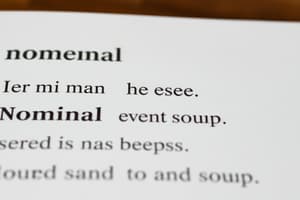Podcast
Questions and Answers
المقارنة في الجملة تكون بين اثنين من جوانب التمثال - ارتفاعه مقابل عرض قاعدته.
المقارنة في الجملة تكون بين اثنين من جوانب التمثال - ارتفاعه مقابل عرض قاعدته.
False (B)
تستطيع الجمل الاسمية تشكيل أسئلة من خلال إعادة ترتيب ترتيب عناصرها.
تستطيع الجمل الاسمية تشكيل أسئلة من خلال إعادة ترتيب ترتيب عناصرها.
False (B)
الجمل الاسمية لها دور هام في نقل التعاريف ووضع العلاقات وإجراء المقارنات وتشكيل الأسئلة في النصوص باللغة الإنجليزية.
الجمل الاسمية لها دور هام في نقل التعاريف ووضع العلاقات وإجراء المقارنات وتشكيل الأسئلة في النصوص باللغة الإنجليزية.
False (B)
الجمل الاسمية تسمح لنا بالتعبير عن أفكار مختلفة دون التقيد بالهياكل الجملية التقليدية أو تقاليد الترقيم.
الجمل الاسمية تسمح لنا بالتعبير عن أفكار مختلفة دون التقيد بالهياكل الجملية التقليدية أو تقاليد الترقيم.
الجمل الاسمية لا تستطيع تشكيل أسئلة في النصوص باللغة الإنجليزية.
الجمل الاسمية لا تستطيع تشكيل أسئلة في النصوص باللغة الإنجليزية.
تستخدم الجمل الاسمية للتعبير عن العلاقات بين الأشياء.
تستخدم الجمل الاسمية للتعبير عن العلاقات بين الأشياء.
الجمل الاسمية تتبع هيكل أساسي معين: فاعل + فعل + مفعول به.
الجمل الاسمية تتبع هيكل أساسي معين: فاعل + فعل + مفعول به.
تنتهي الجمل الاسمية بعلامات ترقيم مثل الفقاعة.
تنتهي الجمل الاسمية بعلامات ترقيم مثل الفقاعة.
يمكن للجمل الاسمية أن تستخدم لوصف مقارنات.
يمكن للجمل الاسمية أن تستخدم لوصف مقارنات.
الجملة 'الكتاب كان على الطاولة' هي جملة اسمية.
الجملة 'الكتاب كان على الطاولة' هي جملة اسمية.
Flashcards are hidden until you start studying
Study Notes
Nominal Sentences
In English grammar, a nominal sentence is a type of sentence where the subject is a noun phrase rather than a pronoun. A nominal sentence expresses what someone says about something or what something means. It follows this basic structure: subject + verb + object. Unlike declarative sentences, which typically begin with a capital letter and end with a period, nominal sentences do not follow standard punctuation rules due to their unique function. Instead, they often end with conjunctions like 'and,' 'or,' or prepositions like 'of' or 'with,' depending on the context.
Nominal sentences can serve several purposes within a text:
Expressing Definitions
A common purpose of nominal sentences is defining a word. For example:
The cat is a mammal. — Subject: the cat — Verb: is — Object: a mammal
This sentence defines "cat" as belonging to the category "mammals."
Explaining Relationships between Objects
Another use of nominal sentences is to establish relationships among objects. Take, for instance:
The fork is on the table. — Subject: the fork — Verb: is — Object: on the table
This sentence conveys the location of the fork relative to the table.
Describing Comparisons
Comparisons can also be made using nominal sentences, such as:
The height of the statue is greater than the width of the base. — Subject: the height of the statue — Verb: is — Object: greater than the width of the base
Here, the comparison is between two aspects of the statue - its height versus its base's width.
Forming Questions
Nominal sentences can also form questions by rearranging the order of elements. For example:
What is the color of the car? — Subject: what — Verb: is — Object: the color of the car
By starting the sentence with "What," it becomes a question seeking information about the car's color.
In summary, nominal sentences play a crucial role in conveying definitions, establishing relationships, making comparisons, and forming questions in English texts. They allow us to express various ideas without being restricted by traditional sentence structures or punctuation conventions.
Studying That Suits You
Use AI to generate personalized quizzes and flashcards to suit your learning preferences.



